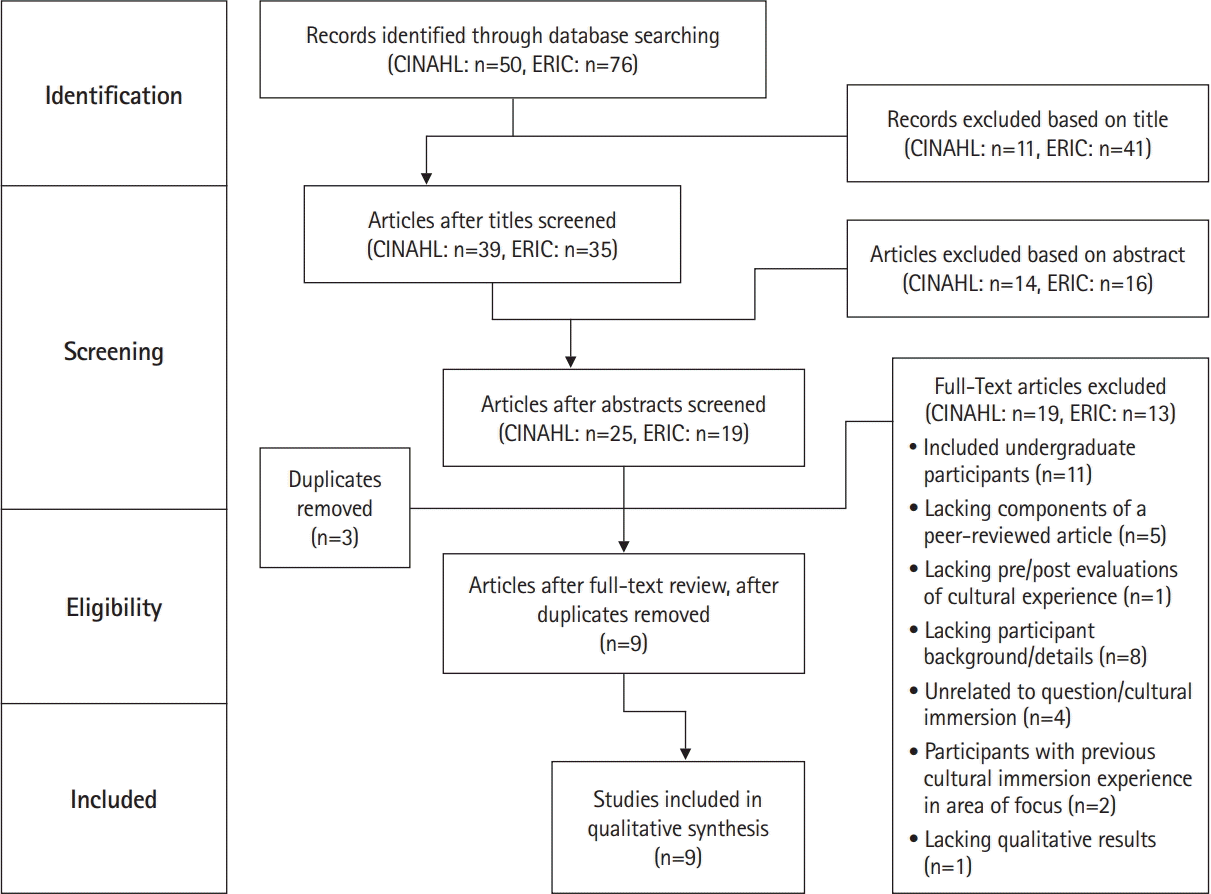|
Choi et al. [13] (2015) |
100 |
Counseling |
Five master’s-level counseling students (4 females, 1 male) attending a midsized university located in the United States. All participants were White Americans, ages 26 to 38. |
South Africa |
Participants were involved in a 14-day study abroad class in South Africa. A variety of educational, cultural, and field experiences were undertaken by the participants. Viewpoints about the cultural immersion experience were gathered through semi-structured interviews 6 months after the experience. A qualitative methodology was used to analyze information gathered during 60- to 90-minute interviews. Data analysis revealed 5 major themes. |
5 Themes: (1) the meaning of being American; (2) socio-political awareness; (3) engagement with South Africans and their local communities; (4) appreciation of life; and (5) commitment to change |
|
Crowe et al. [17] (2016) |
75 |
Occupational therapy |
Thirty-six students from the United States, ages 20–60+ participated in an immersion experience. |
Mexico |
An academic course involving a 12 day experience in Oaxaca, Mexico immersed participants in a foreign culture. Using qualitative analysis with guided questions and focus groups, 4 main themes were derived from participants’ opinions and thoughts about the experiences. |
4 Themes: (1) natural remedies; (2) mind, body, spirit, connection; (3) increased openness; and (4) challenges of integrating traditional and western medicine |
|
Goodman [14] (2016) |
75 |
Nursing |
Seventeen graduate nursing students, ages 24–64 participated in an immersion experience. |
Guatemala |
Students kept reflective journals of their experiences including teaching, healthcare, and general cultural interaction with people in rural villages. Notes and journals were collected from participants and analyzed to reveal 9 themes. |
9 Themes: connection with: (1) community; (2) environment; (3) local partners; (4) one’s own level of comfort; (5) others (patients, colleagues, classmates); (6) self and internal peace; (7) the future; (8) other underserved communities; and (9) nursing profession |
|
Hipolito-Delgado et al. [9] (2011) |
75 |
Counseling |
Three first-year female graduate students at an urban university in the United States participated in the experience. Two identified as heterosexual and 1 identified as homosexual. |
Students were allowed to choose a setting with a culturally different population. |
Participants were enrolled in a semester-long assignment in an academic course in which they selected a cultural environment different from their own based on one or more of the following: race, ethnicity, gender, sexual orientation, ability, or age. Students were immersed in the environment, kept weekly journals, and compared those observations to the counseling literature related to their community of choice. |
3 Themes: (1) increased awareness; (2) increased knowledge; and (3) increased skills |
|
Ishii et al. [8] (2009) |
100 |
Counseling |
Fifteen female master’s-level counseling students, ages 24–56, from a university in the United States participated (11 European Americans, 3 African American, and 1 bi-ethnic). |
New Mexico |
Students participated in 3 preparatory meetings with various educational methods prior to the experience. Participants travelled to cultural and historical sites in New Mexico, USA, representing Aztec, Hispanic, and Pueblo Native American cultures. Follow-up data resulted in 5 emergent themes. |
5 Themes: (1) cognitive reactions; (2) affective reactions; (3) perceptual reactions; (4) empathy; and (5) cultural dissonance |
|
Peiying et al. [12] (2012) |
75 |
Occupational therapy, physical therapy speech pathology |
15 Female participants from Australia, ages 22–30 participated in the immersion experience. |
China, India |
Students participated in a 4-week immersion experience in either China or India. Journals and guiding questions were completed throughout the experience. Narrative data were analyzed by blinded researchers who classified feedback into 5 major themes. |
5 Themes: (1) increased vigilance and adaptation to environment; (2) uncertainty and anticipation; (3) grappling with supremacy; (4) recognizing and appreciating differences; and (5) cultural immersion and development |
|
Prosek and Michel [16] (2016) |
100 |
Counseling |
13 Master’s level students, ages 21–37, from programs across the United States participated (12 females, 1 male, 10 European American, 1 African American, 1 Hispanic, and 1 multiracial). |
Ireland |
The counseling students participated in a 13-week multicultural/diversity course. The course involved 11 weeks of education on Irish culture followed by a 10 day cultural immersion experience in Ireland. Students submitted reflection papers and completed interviews used for data analysis revealing 3 themes. |
3 Themes: (1) cultural self-awareness; (2) witnessing peer growth; and (3) global connection |
|
Shannonhouse et al. [15] (2015) |
100 |
Counseling |
10 Graduate students, ages 23–32, participated. (9 females, 1 male, 9 European American, 1 Asian American). |
Costa Rica |
The students participated in a 3-week cultural immersion experience course in Costa Rica. They submitted 210 structured journals that were analyzed using qualitative methodology, revealing 9 themes. |
9 Themes: (1) personal characteristics; (2) past experiences; (3) coping; (4) emotional reactions; (5) communications; (6) relational connections; (7) encouragers/barriers; (8) personal and professional changes; and (9) awareness |
|
Smith-Augustine et al. [11] (2014) |
75 |
Counseling |
Five African American female graduate students, ages 20–25, from a university in the United States participated. |
Belize |
The students participated in a 3-week study abroad in Belize where they interacted with persons from diverse cultural backgrounds. Participants submitted journals for analysis, which revealed 4 themes related to the cultural immersion experience. |
4 Themes: (1) discrimination and prejudice; (2) cultural pride and appreciation; (3) cultural sensitivity; and (4) self-awareness |




 PDF
PDF Citation
Citation Print
Print





 XML Download
XML Download